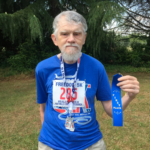 Last week I talked about the cognitive decline that so often comes with aging. I mentioned new research into a mechanism that not only halts, but even reverses that decline, restoring the mental powers of old mice to what they had been when they were much younger. This is great for mice, and the mechanism might just possibly work in humans too. You can bet the researchers will be proposing research with human subjects soon. It would be nice to be able to extend the mental health of your pet mouse, but it would be even nicer to be able to extend the mental health of your grandmother.
Last week I talked about the cognitive decline that so often comes with aging. I mentioned new research into a mechanism that not only halts, but even reverses that decline, restoring the mental powers of old mice to what they had been when they were much younger. This is great for mice, and the mechanism might just possibly work in humans too. You can bet the researchers will be proposing research with human subjects soon. It would be nice to be able to extend the mental health of your pet mouse, but it would be even nicer to be able to extend the mental health of your grandmother.
Mental health is something greatly to be desired, but it is even better when accompanied by robust physical health. Unfortunately, like mental health, physical health also declines with age. Is there an intervention that can be applied to aged mice (or aged people) that can halt or reverse the physical decline that comes with advancing age? At least in the case of mice, the answer is apparently, “Yes.”
In the January 20, 2021 issue of Nature Communications, an article appeared, titled “MOTS-c is an exercise-induced mitochondrial-encoded regulator of age-dependent physical decline and muscle homeostasis.”
Mitochondria are organelles that can be found in most types of cells in both mice and humans. They are the powerplants of the body, converting nutrients into the energy that powers everything. MOTS-c (mitochondrial open reading frame of the 12S rRMA type-c) is a peptide that regulates the aging, inflammation, and stress resistance processes.
The relationship between MOTS-c and physical health is complex. In the research cited above:
- MOTS-c levels increased 11.9-fold in sedentary young adult humans after exercise.
- After a course of MOTS-c injections, old mice on a treadmill ran twice as long and more than twice as far as did untreated old mice.
Humans and mice both produce MOTS-c endogenously, but that production declines with age. At least in the case of old mice, providing supplementary MOTS-c restores performance to the level typical of much younger mice. This leads to some questions for the researchers:
- Does exercising old humans lead to increased MOTS-c levels, and if so, how much of an increase?
- Would injecting MOTS-c into humans enable them to run twice as long and twice as far as they could run prior to treatment?
- Since MOTS-c is a natural substance produced by the body, would Olympic officials consider MOTS-c injections to be illicit “doping?” Would injected MOTS-c be distinguishable from endogenous MOTS-c?
These days, when I go out for a run, I don’t run as far as I typically did fifty years ago, or even forty years ago. Is MOTS-c my ticket to running like I used to run in the old days? I’m keeping an eye on MOTS-c research to see.
BIO:
Allen G. Taylor is a 40-year veteran of the computer industry and the author of over 40 books, including Develop Microsoft HoloLens Apps Now, Get Fit with Apple Watch, Cruise for Free, SQL For Dummies, 9th Edition, Crystal Reports 2008 For Dummies, Database Development For Dummies, Access Power Programming with VBA, and SQL All-In-One For Dummies, Third Edition. He lectures internationally on astronomy, databases, innovation, and entrepreneurship. He also teaches database development and Crystal Reports through a leading online education provider. For the latest news on Allen’s activities, check out his blog at wwwallengtaylor.com or contact him at allen.taylor@ieee.org.